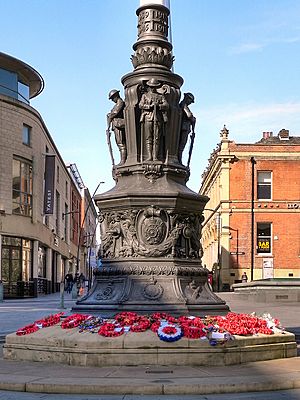Sheffield War Memorial facts for kids
The Sheffield War Memorial, also called the Sheffield Cenotaph, is a special monument in Sheffield, England. It's located in Barker's Pool, right next to the Sheffield City Hall. This memorial is a Grade II* listed site, which means it's a very important historical building. It stands as a tribute to remember those who served and sacrificed in wars.
Contents
Building the Memorial
After the First World War, people in Sheffield wanted a way to remember the soldiers. There was a lot of discussion about where to put a memorial and what it should look like. A special committee looked at many different ideas.
They decided to build it near the City Hall. To make space, some shops north of Barker's Pool were taken down. A competition was held for architects in Sheffield to design the memorial.
The Winning Design
The winner was Charles Denny Carus-Wilson. He was the head of the School of Architecture at the University of Sheffield. He had also served in the war himself. This memorial was his first big public project. The total cost of the memorial was £5,435. This money was raised through donations from the public.
What the Memorial Looks Like
The memorial has a main structure called a cenotaph. A cenotaph is like an empty tomb that honors people whose bodies are elsewhere. On top of it is a very tall flagpole, about 25 meters (82 feet) high.
The Flagpole
The central flagpole looks like a ship's mast. It is made from strong steel and was built by Earle's Shipbuilding in Hull. It is painted white and has a shiny gold ball and crown at the very top.
The Base and Statues
The flagpole stands on a bronze base that is about 5.3 meters (17.4 feet) tall. This bronze part was created by the sculptor George Alexander. It features four statues of soldiers. They stand with their heads bowed and their rifles pointing downwards, showing respect.
The base also has four important symbols. These represent the British Army, the Royal Navy, the Royal Air Force, and the city of Sheffield's own symbol. These symbols face the four main directions (north, south, east, west). You can also see the badges of eight different army units on the base.
The bronze base sits on an eight-sided stone platform. This platform is made from a special stone called Derbyshire Hopton Wood stone. Circular paving surrounds it, forming a traffic island.
Unveiling and Changes
The memorial was officially revealed on October 28, 1925. General Sir Charles Harington Harington did the unveiling. The Bishop of Sheffield, Leonard Burrows, dedicated it.
During the Second World War, the memorial was slightly damaged by bombs. This damage was left unrepaired as a reminder. After the Second World War, more dates were added around the base to remember those from that conflict. The memorial became a listed building in 1983 and was upgraded to Grade II* in 2016.
The memorial has been restored a few times. This happened in 1989 after Barker's Pool was closed to traffic. More restoration work took place in 2005, and the flag-raising system was replaced.
Other Memorials in Sheffield
Sheffield has other important war memorials too.
- The War Memorial Hall opened in 1932 inside the Sheffield City Hall. It has a Roll of honour listing 5,000 names of those who served.
- The York and Lancaster Regiment War Memorial is located in Weston Park.
- The Sheffield City Battalion Memorial is in France, in a place called Serre-lès-Puisieux. This memorial remembers the "Sheffield Pals," who were soldiers from Sheffield in the 12th Service Battalion, York and Lancaster Regiment.


